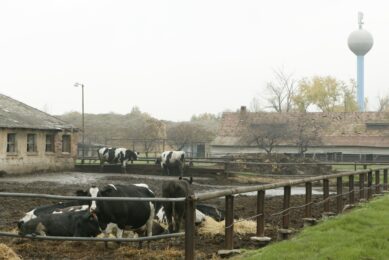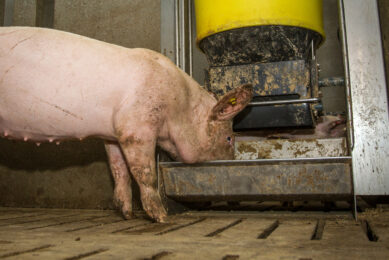Antibiotic use in European pig production: Less is more
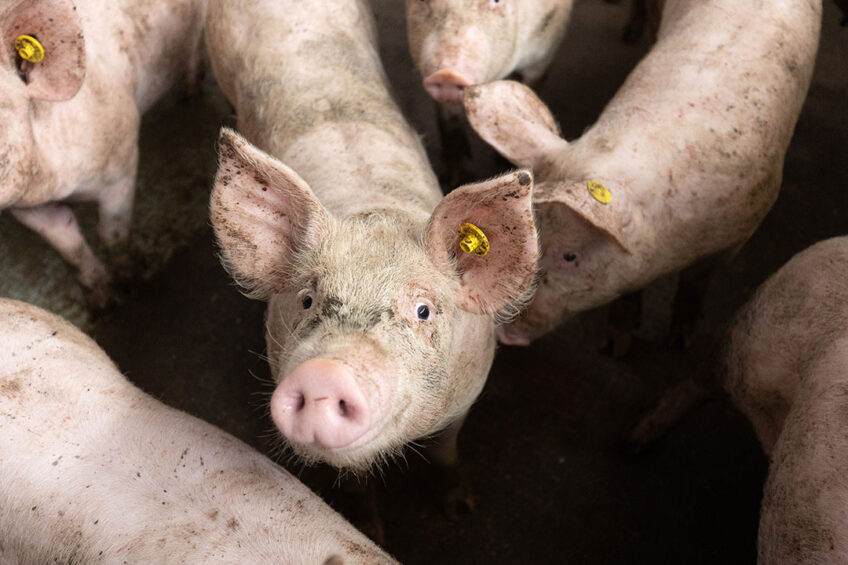
In the European Union, the use of antibiotic growth promotors (AGPs) was banned in 2006. More than 15 years later, many lessons have been learned across the continent. As each member state has its own ways to learn, however, it has sometimes been hard to compare data. A team of scientists from Ghent University, Belgium, pulled it all together.
Various studies have been carried out to learn more about how Europe’s use of antibiotics in pig production has changed in the last 2 decades, in both qualitative and quantitative ways.
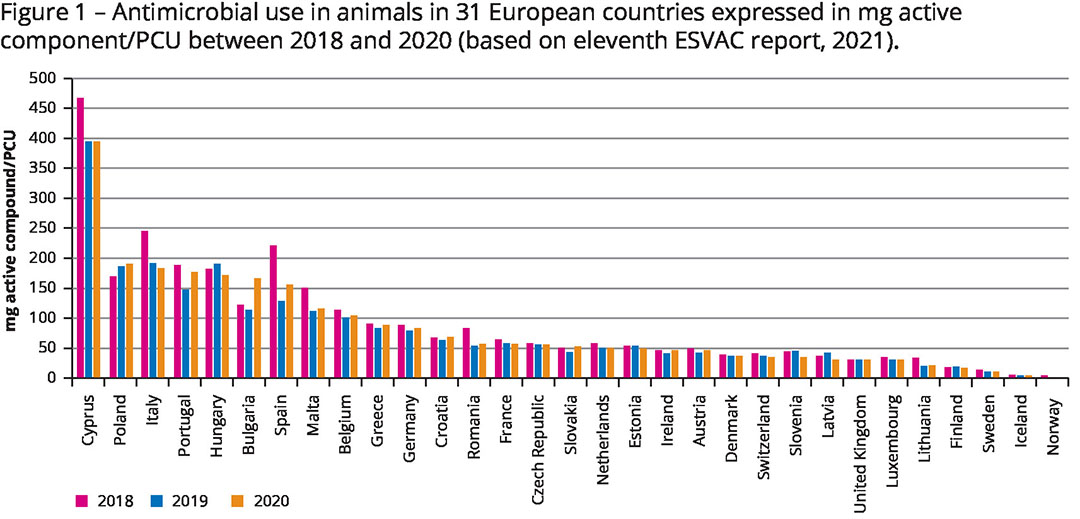
Studies on national sales data
In 2005, the European Medicines Agency (EMA) launched the European Surveillance of Veterinary Antimicrobial Consumption (ESVAC) project. In this project, antibiotic use in animals in Europe is being quantified at country level based on national sales data of veterinary antibiotics. The data up to 2020 provide information on the sales of antibiotics in 31 European countries (see Figure 1). The use is expressed in mg of active component sold in relation to the Population Correction Unit (PCU), which is a proxy for the biomass of the food-producing animal population (including horses) in a country.
The ESVAC data provide a comprehensive and recurrent overview of the total sales of antibiotics in Europe. The results show huge differences between countries, ranging from a low of 2.3 mg/PCU up to a high of 393.9 mg/PCU and with a median value of 51.9 mg/PCU. For the 25 countries that provided sales data for all years between 2011 and 2020, an overall decline in sales (mg/PCU) of 43.2% can be seen, with a noticeable decrease in sales identified for some of the highest scoring countries.
Although these ESVAC data successfully monitor the overall trends in antibiotic use in animals in Europe, it is difficult to extract the evolution in antibiotic use for specific types of animals (e.g., pigs). That is due to many antibiotics on the market being registered for multiple species, and therefore it not being easy to assign them to one specific animal species.
Usage studies on a national basis
Since the ban on AGPs in Europe, the focus has shifted to therapeutic, metaphylactic and prophylactic use of antibiotics in animals. This has resulted in a number of surveys in European countries describing antibiotic use in pigs, both quantitatively and qualitatively. These surveys were conducted in Belgium, Denmark, Spain, Germany, Sweden, France, Italy, Ireland, Finland and Switzerland.
The surveys have been a crucial step towards a more detailed understanding of antibiotic use and its risk factors in pig production. Many of these studies described huge differences in antibiotic use over the course of the production cycle, with the majority of the use in young pigs. Other typical findings include a large variation in antibiotic use between farms within the same country and the frequent application of prophylactic medication, often with important contributions of critically important antibiotics such as third generation cephalosporins and fluoroquinolones. In addition, increased farm size, veterinarian, poor biosecurity, and farm health management have all been described as drivers for antibiotic use. Some of the studies provided evidence for the possibility of reducing antibiotic use over time, without necessarily jeopardising animal health and productivity.
Multi-country usage studies
A limitation of the described surveys is the huge variation in metrics used to quantify antimicrobial use, hampering comparisons between countries. Therefore, the execution of multi-country studies, using the same quantification methodologies, was a big step forward. The first multi-country study – on France, Germany, Sweden, and Belgium – was described by an international team of European researchers in 2016. In this study, it was found that weaned piglets received the most antibiotics, followed by suckling piglets.
Furthermore, it was observed that antibiotic use was significantly associated across age categories, indicating that farms with high use of antibiotics in piglets also used more antibiotics in their finishers. This may, among other things, be explained by farmers’ habits and behaviour. However, above all, the study showed surprisingly large differences in antibiotic use between the countries included. These differences between countries, but also between herds, might be related to the differences in disease prevalence and/or differences in the level of biosecurity. However, they may also reflect variations in the attitude towards antibiotic use of farmers and veterinarians.
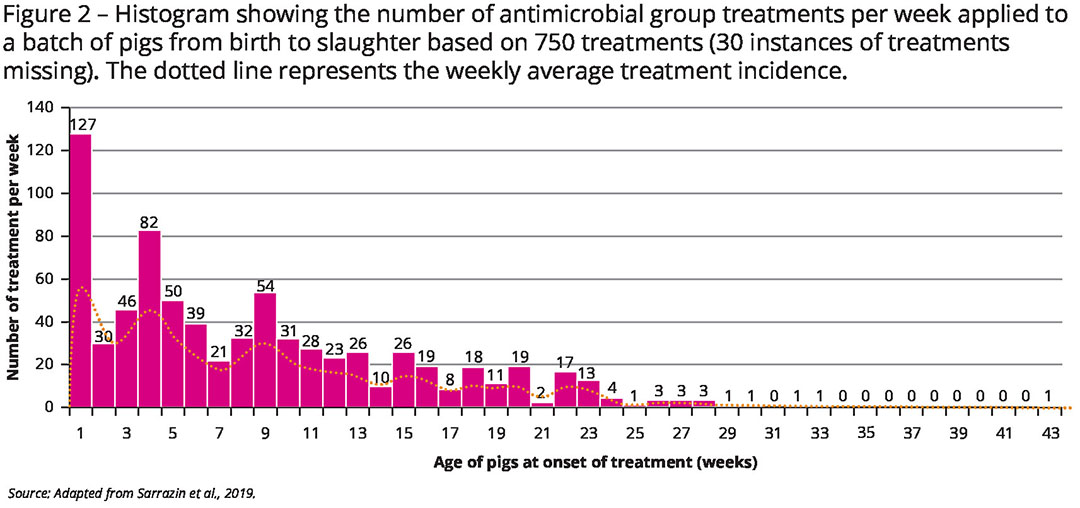
Planned study involving 9 countries
Responding to the challenge of collecting good quality antibiotic use data at farm level, a European study involving nine European countries was set to follow all antibiotic use administered within a single batch for a total of 180 pig farms. In this study from 2019, antibiotic use was quantified using the treatment incidence (TI) indicator based on the defined daily doses for animals (DDDvet) as provided by the European Medicines Agency (EMA). TIDDDvet represents the percentage of time a pig is treated with antibiotics in a defined period.
The results of the multi-country study revealed that the average European pig was treated 9% of its lifetime with antibiotics. The majority of antibiotics were administered to weaners (69.5% of total TIDDDvet) followed by suckling piglets (22.5% of total TIDDDvet) (see Figure 2).
In this multi-country study, antibiotic use again varied considerably between countries and farms. It is noteworthy that 11.7% of the farms did not use any group treatments of antibiotics throughout the production round. Yet, the large variation in antibiotic use patterns (choice and/or amount of antibiotics used) between farms revealed the need to take action towards more responsible antibiotic use, such as reducing use at strategic times in combination with increased biosecurity. In addition, the selection of the used molecules could change away from the use of the highest priority critical important antibiotics such as colistin, fluoroquinolones and third and fourth generation cephalosporins.
Extended spectrum penicillins (31.2%) and polymyxins (24.7%) were the active substances most often used in group treatments in this multi-country study, with the majority administered through feed or water (82%), although again considerable differences were observed regarding the administration route between countries.
Herd level monitoring of data
Currently, a network on quantification of veterinary antimicrobial usage at herd level and analysis, communication and benchmarking to improve responsible usage (known as AACTING) describes 25 different herd-level antibiotic use data collection systems for pig production originating from 15 different European countries.
These systems differ in many ways, including the type of collected data (e.g., mg antibiotics used versus days of treatment; kg of biomass versus weight and number of animals at risk), the performed analyses and their respective output (e.g., mg/kg biomass versus treatment incidence). At the same time, they share key components such as data collection, analysis, benchmarking and reporting.
Further harmonisation of methods and processes, as well as the underlying DDDvet values, could lead to improved comparability of outcomes and less confusion when interpreting results across systems. Having these types of animal-specific data collection systems at farm level is extremely helpful, as they allow description of species-specific evolutions in antibiotic use and assist in creating antimicrobial reduction goals over time both for farmers and veterinarians.
Biosecurity and health management
A total of 116 pig health experts from different European countries were asked to rank antibiotic use alternatives based on a list of defined criteria that assess their expected effectiveness, return of investment and feasibility. The highest ranked alternative to antibiotic use was improved biosecurity of the farm, followed by increased and improved vaccination strategy, the use of zinc (focusing on weaned pigs), the provision of high-quality feed and the use of improved diagnostics. Aside from the use of zinc, which has been banned for medicinal use in Europe since the end of 2021, these alternatives are within reach for all pig producers.
Several management factors were also associated with reduced antibiotic use in various studies. In a study on four European countries, lower antibiotic use was linked to 3 parameters, namely external biosecurity, a higher weaning age (> 24 days) and a five-week batch management system.
Towards 0 antimicrobial use
Raised Without Antibiotics (RWA) is a certification mark that is known in countries such as Denmark and the United States. However, specific inclusion criteria for RWA production and the implementation of RWA in a large number of herds with varying management and housing conditions has had only limited investigation.
In a recent Belgian study, 28 Belgian pig herds were enrolled, and their antibiotic use was followed for a period of 35 months. The goal of the study was to evaluate to what extent pig farms could be coached towards antimicrobial-free pig production and to what extent they could also maintain this status over time. The results of the study showed that 13 out of the 28 herds were successfully raising pigs without antibiotics after a coaching period of one year. 1 year later, 12 of the 13 were still maintaining this status. Remarkably, RWA herds applied fewer vaccinations, were smaller (median 200 sows, range 85–300) compared to non-RWA herds (median 350 sows, range 180–1,250) and applied a 3- and 5 -week batch farrowing system more frequently compared to the 4 -week system which was used significantly more in non-RWA herds.
Conclusions
Based on the described evolution in antibiotic use in pig production in Europe in the last decade and based on the results already obtained today by the leading producers and countries, it is clear that the use of antibiotics will further diminish and hopefully will become an exceptional act in future pig farming. Obviously, for the majority of farms both within and beyond Europe, this will require further efforts and focus on better husbandry, biosecurity and management.
It will be key to get everybody involved, including the small-scale breeders and those who are resistant to to change. Ultimately this reduction will also result in the levelling off, and eventually even reversal, of resistance selection, leading to further benefits for animal health as well as human health, global food safety and food security.
* This is an abridged and approved summary of a scientific publication in the peer-reviewed magazine Antibiotics. The full article was co-authored by Philip Joosten, Ilias Chantziaras, Elise Bernaerdt, Merel Postma and Dominiek Maes, attached to Ghent University, Belgium, and Wannes Vanderhaeghen, Centre of Expertise on Antimicrobial Consumption and Resistance in Animals (Amcra), Belgium.




